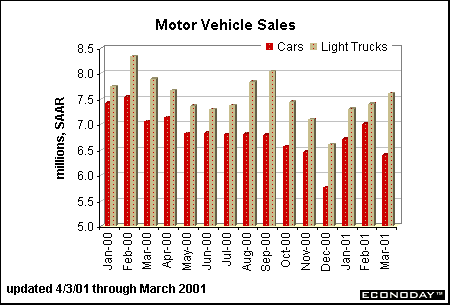|
A True Sign of Consumer Confidence
The smoother road of motor vehicle sales
Consumer confidence measures are well and good in helping to determine the path of consumer spending - as far as they go. It is true that consumers get worried about their jobs when layoff announcements make big headlines. They are also sensitive to personal information - did their neighbors lose their jobs? Has a member of the family lost his job? And no doubt consumers are also sensitive to stock market headlines. Given all this, maybe we should hide under the cover and not come out for a while.
Yet, putting aside the rhetoric about Alan Greenspan's interest in consumer confidence, most economists focus on real behavior and not qualitative measures like confidence indices. Domestic car sales did drop sharply in March to a 6.4 million-unit rate. Except for the weather related drop in car sales in December; the March selling pace is the lowest since March 1993. This would be serious indeed, if it wasn't for the strength in light trucks. These include minivans and sports utility vehicles (SUVs). Although not at the fastest selling rate, the pace for light trucks in March was about as good as we've seen in this cycle. And keep in mind that SUVs are often more expensive than cars.

It really is more useful to add up total domestic car and truck sales to get a better sense of total motor vehicle sales because the selling rate of autos has gone down significantly in the past ten years. Indeed, light truck sales surpassed car sales in mid-1998. The chart below depicts the total level of motor vehicle sales over the past 15 months. Sales have softened in the first quarter of 2001 relative to the first quarter of 2000, posting a 7.7 percent drop. But then if one looks at the selling pace for the entire year, 14.4 million units in 2000, the decline in the first quarter is only 1.8 percent.

Given all the heart pounding and brow beating with the stock price decline, one would expect that the U.S. economy is at doom's door. In fact, American consumers have bought only slightly fewer cars and trucks in the first quarter of the year - this with a 60 percent Nasdaq plunge and 10 percent Dow drop in their face. In fact, the drop is larger for cars than for minivans and SUVs, which actually are higher-priced!
Many analysts believe that the stock market is a leading indicator of economic activity. Indeed, it is one of the components of the index of leading indicators. Yet, the stock market has predicted several recessions - that never took place.
Actually, in this high tech age of instant information flows, one would have expected a quicker response between a drop in the stock market (which actually began early last year) and an economic recession. U.S. economic activity has moderated significantly in the second half of 2000; some economists are even predicting a slight dip in real GDP growth in the first quarter of 2001. But the healthy pace of motor vehicle sales in the first quarter indicates that the U.S. economy is not in such dire straits as dramatized by the stock market. If we measure consumer confidence by the pocketbook, confidence wouldn't fare so poorly.
Evelina M. Tainer, Chief Economist, Econoday
|